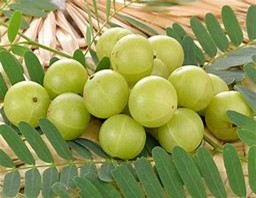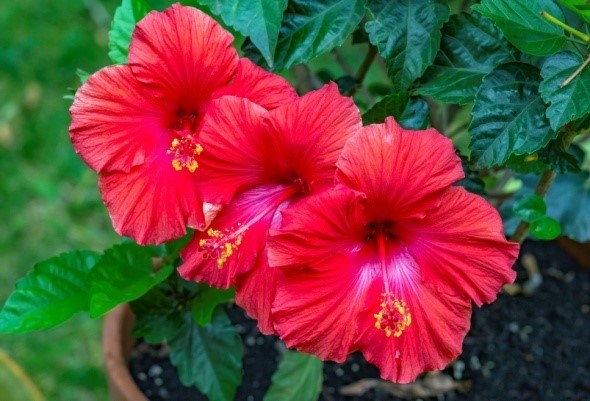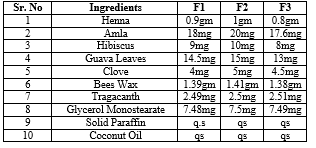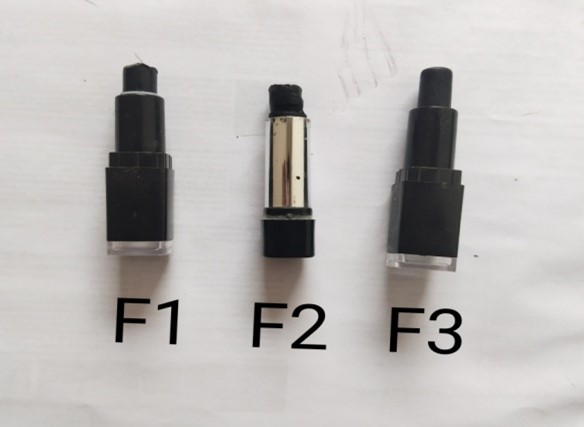Abstract
Hair dye sticks have gained popularity due to their convenience, precision, and ease of application. This study aims to formulate an effective hair dye stick by combining the benefits of traditional hair dyes with the practicality of stick formulations. The formulation process involves selecting appropriate dyes, binders, solvents, and additives to achieve desired color intensity, adhesion, and ease of use. Various formulations are tested for stability, color fastness, skin compatibility, and overall performance. The results demonstrate the successful development of a hair dye stick that offers long-lasting color, minimal skin irritation, and convenient application. This research contributes to the advancement of hair dye technology, providing consumers with a practical and efficient solution for hair coloring needs. This study presents the development of a herbal hair dye stick utilizing natural extracts of Henna (Lawsonia inermis), Amla (Phyllanthus emblica), Hibiscus (Hibiscus rosa-sinensis), and Guava leaves (Psidium guajava). These botanical extracts are known for their hair conditioning, coloring, and strengthening properties. The formulation process involves optimizing the concentration of each extract, selecting suitable binders, solvents, and additives to create a stable and effective hair dye stick. The formulated sticks are evaluated for color intensity, coverage, durability, skin compatibility, and overall performance. Results demonstrate that the herbal hair dye sticks provide vibrant coloration, excellent coverage of gray hair, and minimal skin irritation. Furthermore, the incorporation of these natural extracts enhances hair health and promotes natural shine. This research contributes to the development of eco-friendly and sustainable alternatives in the field of hair coloring, catering to the increasing demand for natural and herbal beauty products.
Keywords
Hair dye stick, Hair colouring, gray coverage
Introduction
Hair dye has evolved significantly over the years, becoming an integral part of fashion and self-expression. This extensive transformation is a testament to the dynamic intersection of science, culture, and personal identity. From ancient civilizations to modern times, the desire to modify one's hair color has persisted, leading to a fascinating journey through the history and development of hair dye. In the earliest records of human history, evidence suggests that ancient Egyptians were among the first to experiment with hair color. Henna, a natural dye derived from the leaves of the Laws onia interims plant, was used to create various shades of red and brown. This practice not only had aesthetic value but also held cultural and religious significance. As civilizations progressed, so did the methods of altering hair color.As the demand for hair dye grew, so did the need for safer and more reliable products. Scientific advancements led to the development of ammonia-based dyes, providing longer-lasting and more vibrant results. The 1980s saw the emergence of semi-permanent and demi-permanent dyes, offering consumers greater flexibility and reduced commitment. Since ancient times hair coloring has been an art. Probably one of the best ways to give yourself an identity. This is because most people pick one specific organic color and stick to it throughout their life. Research by The Atlantic shows that over 70% of women today dye their hair. Men as well cover grays, highlight natural hair color, and get a whole new look. However, not all hair dyes are effective. In fact, some can cause considerable damage more than the benefits it offers to you. And this is why you need to be careful before choosing any hair dye. Luckily, today we have natural hair dyes that will give great organic hair color and still be gentle on our skin.[1] There are some natural ingredients which can be used as hair dye those are- The tradition of using henna as a natural hair dye is deeply rooted in history, spanning across cultures and generations. Derived from the leaves of the Laws onia interims plant, henna has been a symbol of beauty, artistry, and cultural significance for centuries. This introduction delves into the rich tapestry of henna's origins, its unique coloring properties, and the enduring appeal that has made it a beloved choice for individuals seeking a natural and vibrant transformation for their hair. Henna's journey as a natural hair dye begins in ancient civilizations, where it was not merely a beauty ritual but a symbol of cultural identity and celebration. Its usage can be traced back to regions like North Africa, the Middle East, and South Asia, where henna played a central role in various ceremonies, including weddings, festivals, and religious rites. The intricate application of henna designs, known as mehndi, became an art form, conveying messages of love, luck, and protection.
The allure of henna as a hair dye lies in its ability to impart a spectrum of warm, red tones, ranging from subtle auburn to deep burgundy. The natural dye molecule lawsone, found in henna leaves, binds to the hair's keratin, resulting in a color that is not only vibrant but also enduring. Unlike chemical dyes that fade over time, henna gradually wears off, allowing for a more seamless transition between colorings and eliminating harsh root lines. The journey into the world of henna as a natural hair dye is a fascinating exploration of cultural heritage, artistic expression, and sustainable beauty practices. From its ancient roots to its contemporary appeal, henna continues to weave a narrative that transcends time and borders. As individuals seek alternatives that embrace both tradition and well-being, henna stands as a testament to the enduring beauty found in nature's bounty, offering a transformative and vibrant experience for those who choose to embrace its rich legacy. Clove, derived from the dried flower buds of the Syzygium aromaticum tree, has long been celebrated for its aromatic and medicinal qualities. Native to Indonesia, this spice found its way into global trade and cultural practices, leaving an indelible mark on various cuisines, traditions, and even beauty rituals. The aromatic richness of clove, with its warm and spicy notes, has made it a staple in perfumery and aromatherapy. However, its application as a natural hair dye unveils a lesser-explored facet of this versatile spice. As a natural hair dye, clove is recognized for its ability to impart warm, reddish-brown tones to the hair. The key coloring component in clove is eugenol, a compound that interacts with the hair's proteins, creating a natural hue without the need for harsh chemicals.

Fig no 1 : The Hair Structure
MATERIALS AND METHODS:
1. Heena:
Plant Name:
Lawsoniainermis
Synonyms:
Henna, Mehndi
Kingdom:
Plantae
Order:
Myrtales
Family:
Lythraceae
Genus:
Lawsonia L
Species:
Lawsoniainermis
Uses:
- Used for temporary body art.
- Henna is used to treat various skin conditions, such as rashes, burns.

Fig no 2 : Henna
2.Guava:
Plant Name:
Psidium guajava
Synonyms:
Common guava, lemon guava, apple guava.
Biological source:
Guava is a tropical fruit-bearing tree in the family Myrtaceae
Kingdom:
Plantae
Division:
Magnoliophyta
Class:
Magnoliopsida
Order:
Myrtales
Family:
Myrtaceae
Genus:
Psidium
Species:
P. guajava
Uses:
- Guava is consumed fresh or processed into juices, jams, jellies, and other food products.
- Guava is valued for its high vitamin C content and various health benefits.
- Guava increases digestion, boosting immunity, and promoting skin health.

Fig no 3: Guava Leaves
-
Amla:
Plant name:
Phyllanthus emblica
Synonyms:
Emblica officinalis, Indian gooseberry, Emblic myrobalan
Biological source:
Amla is a fruit-bearing tree in the family Phyllanthaceae. .
Kingdom:
Plantae
Division:
Magnoliophyta
Class:
Magnoliopsida
Order:
Malpighiales
Family:
Phyllanthaceae
Genus:
Phyllanthus
Species:
P. emblica
Uses:
- Amla is used in traditional medicine for various purposes, including promoting hair health, boosting immunity,
- Amla improving digestion, and enhancing skin health.
- It is also used as a flavoring agent and in the preparation of Ayurvedic formulations.

Fig no 4 : Amla
4.Hibiscus:
Plant name:
Hibiscus rosa-sinensis.
Synonym:
Hibiscus, China rose, Shoeblackplant.
Biological source:
Hibiscus is a genus of flowering plants in the mallow family, Malvaceae. The genus contains hundreds of species that are native to tropical, subtropical, and warm-temperate regions around the world.
Kingdom:
Plantae
Division:
Tracheophyta
Class:
Magnoliopsida
Order:
Malvales
Family:
Malvaceae
Genus:
Hibiscus
Uses:
- Stimulate blood circulation in the scalp.
- Encourage hair growth.
- It can also help to strengthen the hair shaft and prevent breakage.
- Hibiscus can help to condition the hair, making it smoother and more manageable.

Fig No.5: Hibiscus
-
Clove:
Plant name:
Syzygium aromaticum
Synonyms:
Eugenia aromaticum, Caryophyllusaromaticus, Clove tree
Biological source:
Clove is an aromatic flower bud derived from the clove tree, a member of the family Myrtaceae.
Kingdom:
Plantae
Division:
Magnoliophyta
Class:
Magnoliopsida
Order:
Myrtales
Family:
Myrtaceae
Genus:
Syzygium
Species:
S. aromaticum
Uses:
- Clove is used as a spice in cooking and baking.
- Clove used as traditional medicine for its analgesic, antiseptic, and digestive properties.
- It is also used in the production of perfumes and essential oils.

Fig no 6 : Clove
METHODOLOGY
- Collection and authentification of crude drugs
Plant material collection and authentication of Henna:
Collection of henna plant material involves harvesting the leaves, which are then dried and ground into a powder for use. Authentication involves ensuring the botanical identity of the plant through morphological and chemical analysis, including the presence of lawsone.
Plant material collection and authentication of Guava leaves:
Collection of guava involves harvesting the ripe fruits or other plant parts. Authentication may involve morphological examination of the fruit and chemical analysis to confirm the presence of characteristic compounds such as vitamin C and flavonoids.
Plant material collection and authentication of Amla:
Collection of amla involves harvesting the ripe fruits, which can be consumed fresh or dried for later use. Authentication may involve morphological examination of the fruit and chemical
Plant material collection and authentication:
For Collection use clean, sterilized tools such as scissors or pruning shears to collect plant parts. Authentication of Hibiscus species typically involves morphological examination and comparison with known botanical descriptions, keys, and herbarium specimens. It may also involve chemical analysis or molecular techniques for certain purposes.
Plant material collection and authentication: Collection of clove involves harvesting the dried flower buds. Authentication may involve morphological examination of the buds and chemical analysis to confirm the presence of characteristic compounds such as eugenol.
- Extraction of crude drugs
Method of Henna extract:
Place 50 grams of henna powder into a clean glass jar. Pour enough ethanol or water over the powder to completely submerge it. Seal the jar tightly with a lid and shake it to ensure thorough mixing. Allow the mixture to macerate at room temperature for 1-2 weeks, shaking the jar gently every day to facilitate extraction. After the maceration period, strain the mixture through cheesecloth to separate the liquid extract from the solid residue. Store the henna extract in a clean, airtight container away from light and heat.
Method of Amla extract:
Place 50 grams of dried amla powder into a clean glass jar. Pour enough ethanol or water over the powder to completely submerge it. Seal the jar tightly with a lid and shake it to ensure thorough mixing. Allow the mixture to macerate at room temperature for 1-2 weeks, shaking the jar gently every day to facilitate extraction. After the maceration period, strain the mixture through cheesecloth to separate the liquid extract from the solid residue. Store the amla extract in a clean, airtight container away from light and heat.
Method of Hibiscus extract:
50 grams of dried hibiscus petals powder into a clean glass jar. Pour enough ethanol or water over the powder to completely submerge it. Seal the jar tightly with a lid and shake it to ensure thorough mixing. Allow the mixture to macerate at room temperature for 1-2 weeks, shaking the jar gently every day to facilitate extraction. After the maceration period, strain the mixture through cheesecloth to separate the liquid extract from the solid residue. Store the hibiscus extract in a clean, airtight container away from light and heat.
Method of Guava Leaves extract:
Place 50 grams of dried guava leaves powder into a clean glass jar. Pour enough ethanol or water over the powder to completely submerge it. Seal the jar tightly with a lid and shake it to ensure thorough mixing. Allow the mixture to macerate at room temperature for 1-2 weeks, shaking the jar gently every day to facilitate extraction. After the maceration period, strain the mixture through cheesecloth to separate the liquid extract from the solid residue. Store the guava leaves extract in a clean, airtight container away from light and heat.
Method of Clove extract: Place 50 grams of whole cloves powder into a clean glass jar. Pour enough ethanol or water over the powder to completely submerge it. Seal the jar tightly with a lid and shake it to ensure thorough mixing. Allow the mixture to macerate at room temperature for 1-2 weeks, shaking the jar gently every day to facilitate extraction. After the maceration period, strain the mixture through cheesecloth to separate the liquid extract from the solid residue. Store the clove extract in a clean, airtight container away from light and heat.
Method of Preparation:
STEP 1- Phase A (Herbal Extracts):
- Henna (Lawsonia inermis) extract: 25%
- Amla (Emblica officinalis) extract: 10%
- Hibiscus (Hibiscus sabdariffa) flower extract: 15%
- Guava (Psidium guajava) leaf extract: 15%
- Clove (Syzygium aromaticum) extract: 10%
STEP 2- Phase B (Binding Agents):
- Beeswax: 20%
- Tragacanth gum: 3%
- Coconut oil: 2%
- Glycerin monostearate: 5%
- Solid paraffin: 20%
STEP 3-
Mix Phase A ingredients thoroughly. Melt phase B in a double boiler until liquid. Slowly add phase A to phase B while stirring continuously until homogeneous. Pour the mixture into suitable molds to solidify.
FORMULATION TABLE:


Fig no 7 : Formulated Hair Dye Stick
EVALUATION PARAMETER:
1.Physical parameters:
Colour:
The colour of formulation was checked manually and observed.
Odour:
The smell of Formulation was checked by applying preparation on hand and feel the fragrance.
Appearance:
Visually checked the appearance of the formulation.
2.Consistency:
The consistency was evaluated by applied on the skin.
3. Determination of pH
The Ph of sunscreens was determined using a digital pH meter. pH was measured after 1g of the formulation was dissolved in 100ml of newly prepared distilled water for 2 hours. The purpose of this study was to guarantee that the pH of the produced sunscreens is similar to the pH of the skin after 24 hours of use. The results were triple-checked, and S.D. was recorded.
4.Determination of Viscosity:
The Brookfield viscometer was used to test viscosity, with the proper number of spindlesselected. A 50 ml beaker was used to hold 40 gm of preparation until the spindle groove was
dipped and rpm was set. Sunscreen viscosity was measured at 5, 10, 20, 50, and 100 rpm. The viscosity was computed using the factor obtained from the reading.
5.Spreadability:
The spreadability of sunscreens determined by two slides are taken and sample was placed on one slide. Another slide was placed on the first slide. 100g of weight was kept on the slides so that it spreads as a thin layer. Weight was being eliminated much high than the prisons. Next weight of 20g was kept on the upper slide. It was kept on the upper slide. Spreadability was calculated by using following
Formula,
S= M. L/M
M= wt. tied to upper slide
L= Length of glass slide
T= Time taken to separate the slides
6.Irritancy Test:
Mark an area (one sq.cm) on the left hand dorsal surface. The cream was applied to the specified area and time was noted. Irritancy was checked if any for regular interval up 24hrs and reported.
7.Homogeneity:
The formulation was tested for the homogeneity by visual appearance and touch.
8.Solubility Testing:
Solubility testing of a hair dye stick typically involves assessing its solubility in various solvents such as water, ethanol, acetone, and oil. This helps determine the stability and compatibility of the product with different substances it might come into contact with during use. Testing involves immersing the hair dye stick in each solvent, observing any changes, and noting the results.
RESULT AND DISCUSSION:
Determination of physical parameters

Determination of pH

Determination of Viscosity

Determination of Spreadability

Homogeneity

In conclusion, the herbal hair dye stick project aimed to develop a natural and effective hair dye product with desirable characteristics such as spreadability and viscosity. Through careful experimentation and analysis, valuable insights were gained regarding the performance and quality of the herbal hair dye stick. The spreadability testing revealed the ease of application and coverage of the hair dye stick, providing important information for user experience and effectiveness. By calculating the spreadability using the weight and length of the applied hair dye stick, we were able to quantify its spreadability and make recommendations for potential improvements or adjustments to optimize the product.Additionally, the viscosity measurement process provided crucial data on the flow behavior and consistency of the herbal hair dye stick. By using a viscometer to measure the time taken for the dye sample to flow through a capillary tube, we accurately determined its viscosity and assessed its suitability for practical application. Overall, the herbal hair dye stick project demonstrated the feasibility of creating a natural and high-quality hair dye product. The conclusions drawn from the spreadability and viscosity testing provide valuable insights for further product development and refinement. By documenting the experimental procedures, measurements, calculations, and results, we have established a solid foundation for future research and innovation in the field of herbal hair care products.
ACKNOWLEDGEMENT:
The success and outcome of this project required a lot of guidance and assistance from many people. I am extremely privileged to have got this all along with the completion of my project. All that I have done is only due to such supervision and assistance which I cannot forget to thank. I am highly thankful to the Department of Pharmacognosy and the Department of Pharmaceutics at MIBP COLLEGE, Gondia for providing various facilities like library facility during literature survey, laboratory, and chemicals/reagents facilities during experiments and many more. I delightedly wish to express my respect and gratitude to the principal mam as well as my guide Mr. Rahul G. Chaudhari sir for his support and encouragement for leading all the facilities required to proceed with our study. I also express my deep gratitude to all my project group members namely Vikram, Abhay, Yash who took a keen interest in the project work and provided me with unconditional support and co-operation. I am also thankful to Navin tank sir, K. Uikey sir, Vineet patel sir and all those people who directly or indirectly co-operated me for completion of the project. Last but not the least, I express a deep sense of gratitude to my parents, family and friends for their kind and valuable support.
REFERENCES
- Y Madhusudan Rao. “Formulation and evaluation of commonly used natural hair colour”, NPR, Vol. 7, Oct 2006, Page No-45-48.
- Suchita Gokhale. “ A review of natural ingredients as hair dye” IJPPR, Vol. 20, Issue 3, ISSN 2349-7903, Feb 2021, Page No-44-47.
- Jyotsnna H Waggh. “ Formulation and Development of Polyherbal Hair Dye”, JETIR, Vol.10, Issue 3, ISSN 2349-5162, March 2023, Page No-542.
- K. H. Prabhu. “Plant based natural dyes and mordant”, ISSN 2231-3184, Jan 2012, Page No-649
- Monal Gargote. “Formulation of Hair colour from nature”, IJSER, Vol.3, Issue 8, ISSN 2225-5518, Aug 2012, Page No- 66.
- Miss. Mane Ashwini Ganpat. “ Formulation and evaluation of herbal hair dye”, IJCRT, Vol. 9, Issue 12, ISSN 2320-2882, Dec 2021,Page No-454
- Z. Shahi. M. Khajch. “ Review of the natural resources used to hair colour and hair care products”, JPSR, Vol 9, ISSN 0975-1450, March 2017,Page No- 1026
- Phadatare Suvarna P. “ Comparative study of dyeing efficiency and retention capacity of herbal hair dye”, IJRAP, March 2013, Page No-198
- Mitchell Ferrera Dario.”Types of hair dye and their mechanism of action”, MDPI, ISSN 2079-9284, April 2015, Page No-110-126
- Pranjali Chahande.”Different eras of Hair coloring”, IJNRD, Vol 7, ISSN 2456-4184, July 2022, Page No-35
- Dr. Rachel Adams. "The Impact of Hair Dye Stick Ingredients on Scalp Health" , IJRAP, March 12, 2023, Page No. 69
- Mark Taylor. "Trends and Innovations in Hair Dye Stick Packaging" ,IJSER, Vol 5, ISSN 2255-5222, Oct 5, 2022, Page No. 52-98
- Dr. Emily White. " The psychological Effects of Hair Dye stick" ,NPR, Vol.9, June 20, 2024, Page No. 655-911
- Dr. Michael Brown. "Safety Assessment of Hair Dye Stick Application Methods" ,IJNRD, Vol.8, ISSN 1080-1100, Feb 8, 2023, Page No. 45-58
- Dr. Sophia Martinez. " Efficacy of Natural Ingredients in Hair Dye Sticks" , IJCPR, Vol.4, Issue 13, ISSN 4509-4621, September 16, 2022, Page No. 62-96
- Sarah Johnson. "Consumer Satisfaction and Brand Loyalty in Hair Dye Stick" , JETIR, Vol.5, ISSN 896-995, April 10, 2024, Page No.103-120
- Dr. Emma Garcia. "Environmental Impact of Hair Dye Sticks" ,IJCPR, Issue 9, ISSN 2348-5000, May 6, 2023, Page No. 599
- John Smith, "Advancement in Hair Dye Stick Technology" ,IJSPR, Vol.6, ISSN 6999-7450, Aug 18, 2024, Page No. 355
- Rollison DE, ''Personal hair dye use and cancer'' IJNRD, Vol.20, Sep–Oct 9 Page no. 413–439
- Ames BN, "Hair dyes are identification of a variety of mutagenic ingredients": NRD, Issue 19, ISSN 6709- 7899, Jun 72, Page no. 2423–2427.
- Ferguson LR, "Direct-acting mutagenic properties of some hair dyes " IJSPR, Vol.2, Jan26, Page no.41–46
- Palmer KA, "The mutagenic assay of some hair dye components" IJCPR, Vol.6, ISSN 3773-4566, Sep–Oct, Page no. 87–91.
- Murata M,"Oxidative DNA damage induced by hair dye components" IJNRD, Vol.5, ISSN 4580-5678, June 2006 Page no. 184–191
- Watanabe T, "Mutagenicity of commercial hair dyes"IJSPR, Issue 11, ISSN 2367-5891, Oct 1990, Page no. 303–308
- Albano G, "Mutagenicity of commercial hair dyes" NPR, Vol.9, ISSN 1523- 3471, Jan 2000, Page no. 171–175


 Rahul G. Chaudhari *
Rahul G. Chaudhari *
 Virendra D. Sarkar
Virendra D. Sarkar
 Abhay D. Lilhare
Abhay D. Lilhare
 Vikram K. Sakure
Vikram K. Sakure
 Yash A. Agarwal
Yash A. Agarwal













 10.5281/zenodo.12700610
10.5281/zenodo.12700610